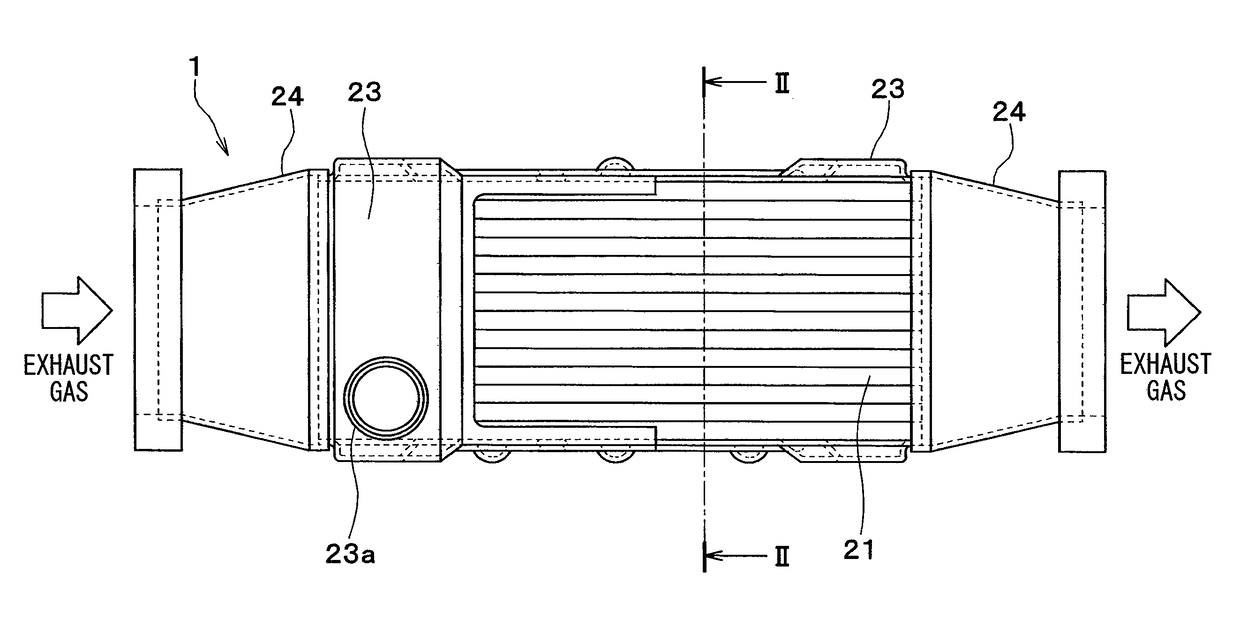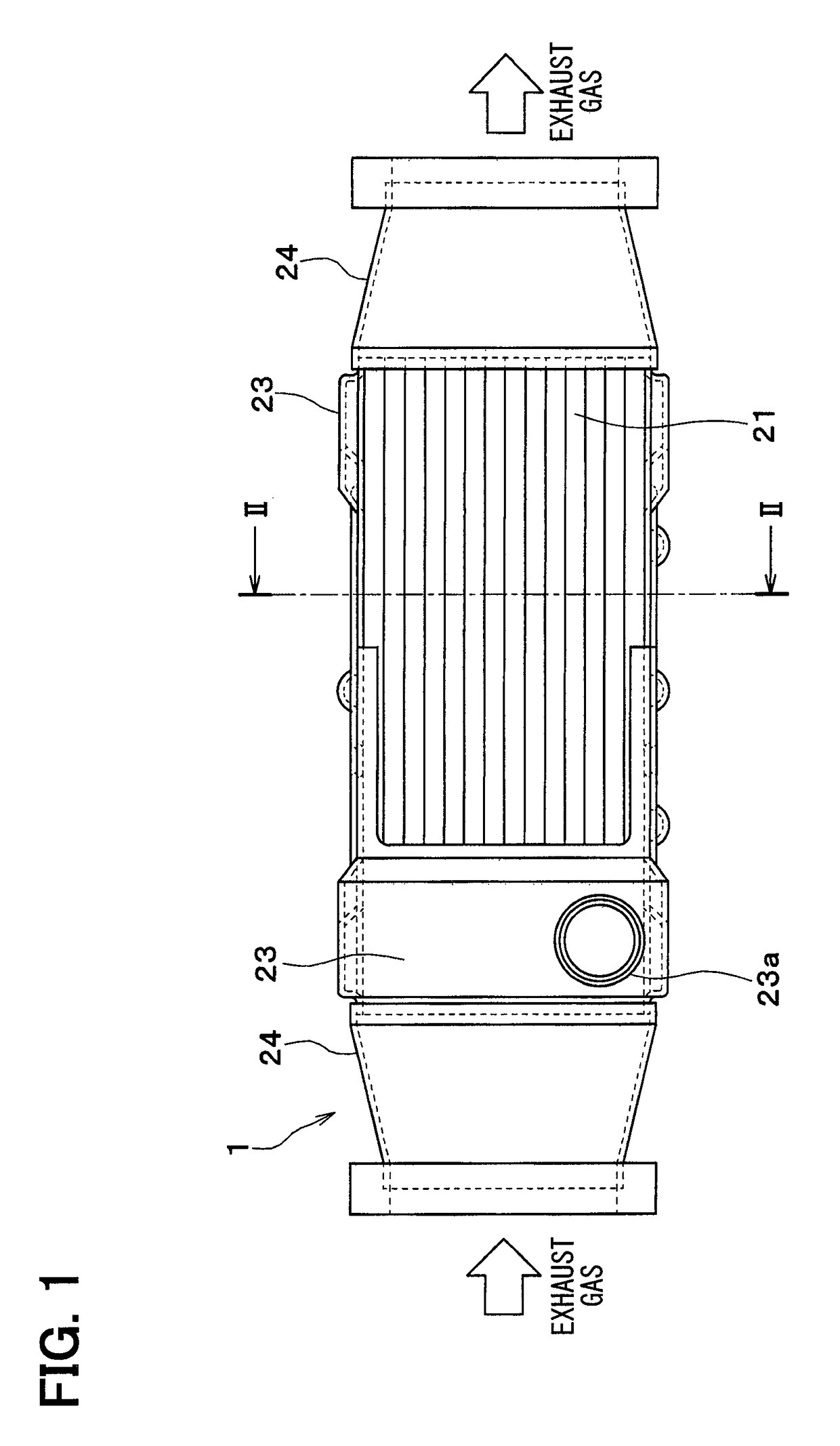Method for manufacturing heat exchanger, and heat exchanger
a technology of heat exchanger and manufacturing method, which is applied in the direction of indirect heat exchangers, light and heating apparatus, laminated elements, etc., can solve the problems of increasing material cost, increasing the thickness of plating film, and affecting the performance of heat exchangers, etc., to achieve high corrosion resistance, increase material cost, and secure corrosion resistance
- Summary
- Abstract
- Description
- Claims
- Application Information
AI Technical Summary
Benefits of technology
Problems solved by technology
Method used
Image
Examples
first embodiment
[0028]A first embodiment is described with reference to FIGS. 1-5. In the present embodiment, a heat exchanger according to the present disclosure is applied to an exhaust heat exchanger (EGR cooler).
[0029]An EGR cooler 1 is an exhaust gas heat exchanger. When exhaust gas generated by combustion in a non-illustrated internal combustion engine (engine) is recirculated to the engine, the exhaust gas is cooled by a cooling water (cooling medium) of the engine. As shown in FIGS. 1-3, the EGR cooler 1 includes plural tubes 21, an inner fin 22, a water tank 23, and an exhaust tank 24. These members 21 to 24 are made of an aluminum alloy, and are joined by brazing.
[0030]As shown in FIG. 2 and FIG. 3, the tube 21 is a pipe configuring an exhaust path 21a along which exhaust gas flows, and the exhaust gas flows through the interior of the tube 21. Cooling water flows along the exterior of the tube 21, and the exhaust gas and the cooling water are caused to exchange heat via the tube 21.
[0031...
second embodiment
[0048]A second embodiment of the disclosure will be described, based on FIG. 6. In the second embodiment, a film 30 formed on the surface of a core member 20 of a tube 21 and an inner fin 22 has a potential less noble than that of the core member 20. In this embodiment, the film 30 is made of Al2O3.
[0049]Because of this, the corrosion resistance of the core member 20 is relatively high with respect to the film 30. Therefore, the film 30 performs a sacrificial corrosion action with respect to the core member 20, such that the core member 20 can be prevented from corroding.
[0050]As shown in FIG. 6, even in a case where a through hole is generated in the film 30 by corrosion due to an adhesion of condensed water, corrosion of the film 30 advances in a direction (the arrow directions in FIG. 6) parallel to the plate surface of the core member 20, such that the corrosion can be restricted from advancing in the thickness direction of the core member 20.
third embodiment
[0051]A third embodiment of the disclosure will be described, based on FIG. 7. In the third embodiment, a first corrosion-resistant film 31 and a second corrosion-resistant film 32 having potentials more noble than that of the core member 20 are alternately stacked on the surface of a core member 20 of a tube 21 and an inner fin 22, as shown in FIG. 7.
[0052]Each of the first corrosion-resistant film 31 and the second corrosion-resistant film 32 is formed by atomic layer deposition. Also, the first corrosion-resistant film 31 and the second corrosion-resistant film 32 are formed in a crystalline state. In this embodiment, the first corrosion-resistant film 31 is made of TiO2, and the second corrosion-resistant film 32 is made of Cr2O3.
[0053]The occurrence of a through hole due to corrosion in the core member 20 can be reliably restricted by alternately stacking the two kinds of corrosion-resistant films 31 and 32 on the surface of the core member 20 of the tube 21 and the inner fin 2...
PUM
| Property | Measurement | Unit |
|---|---|---|
| thickness | aaaaa | aaaaa |
| corrosion resistance | aaaaa | aaaaa |
| thickness | aaaaa | aaaaa |
Abstract
Description
Claims
Application Information
 Login to View More
Login to View More - R&D
- Intellectual Property
- Life Sciences
- Materials
- Tech Scout
- Unparalleled Data Quality
- Higher Quality Content
- 60% Fewer Hallucinations
Browse by: Latest US Patents, China's latest patents, Technical Efficacy Thesaurus, Application Domain, Technology Topic, Popular Technical Reports.
© 2025 PatSnap. All rights reserved.Legal|Privacy policy|Modern Slavery Act Transparency Statement|Sitemap|About US| Contact US: help@patsnap.com



